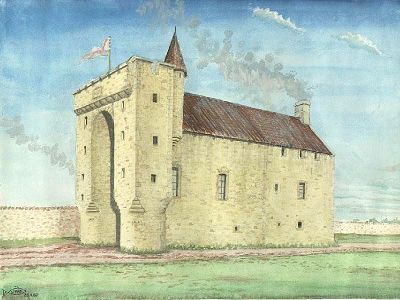|
Artist: Andrew Spratt Custodian of Dirleton Castle. These images are the copyright of Mr. Spratt who has generously given permission to display them here. For more about Andrew Spratt click here. For a complete index of Mr. Spratt's castles on this site click here. Other galleries of Mr. Spratt's work may be viewed at Clan Douglas and Clan Sinclair. Click on the castle to the left to view a larger image and scroll down to read more about the castle. |
|
|
|||
|
To the south of the East Lothian village of Gullane sits the confused yellow rubble remains of Saltcoats castle on the site of an ancient salt marsh (which may explain why the castle is called Saltcoats) ,consisting of a late 16th century oblong hall house with ornate archway and immediately above a row of gargoyles which may have been part of a mock battlement walk way. To the north of this hall house is the shell of an oblong kitchen block and a square mid 17th century style lectern dovecot, all linked by a low courtyard wall raised in the late 17th century. Apparently the castle was originally surrounded by an extensive garden, orchard and to the east a bowling green which was still discernible in the late 19th century all now sadly gone. To the west of the castle is a row of modern (early 19th century) cottages built with material taken from the castle around 1810 when the site was used as a quarry.
Around 1590 local tradition claims a Patrick or Peter Livingtoun killed a notorious wild boar in the woods of Gullane.He was then rewarded with the lands of Saltcoats close to where he killed the wild beast. Certainly the Livingtoun heraldry was amended with a decapitated boar's head above the bend in recognition of this event. Ironically some writers have mistaken this boar's head to be an otter's head which hardly has the same significance. Killing a wild otter is unlikely to merit the gift of the lands of Saltcoats. Patrick built the castle and kitchen in 1590 though the ornate arch may have been added later since this sections gunloops are in a 1600's style. The dovecot may have been built by Patrick's son as it is of a 1630 to 1660 style. Patrick's heraldry and that of his wife Margaret Fettis of Fawside are carved on a datestone of 1590 (which has been recut as 1390 for reasons unknown) embedded in a panel above the doorway of the modern cottage. Likely this panel was originally above the castle arch. In 1695 a G.Livingtoun (possibly Patrick's grandson) built the courtyard wall connecting the castle, the kitchen and the dovecot. It is claimed there was a well nearby but since the whole site is based on drained salt marsh this seems unlikely. In the early 1700's the estate passed to the Hamiltons of Pencaitland and was intact until 1810 when it was turned into a quarry for the next 10 years to built the modern cottages and farm dykes. Thankfully during this demolition Saltcoat's "stones were found to be so firmly cemented together that they were compared to having been sheathed in steel". So the demolition was abandoned and at least some of the castle survives for us to view today.
Andrew Spratt
|
